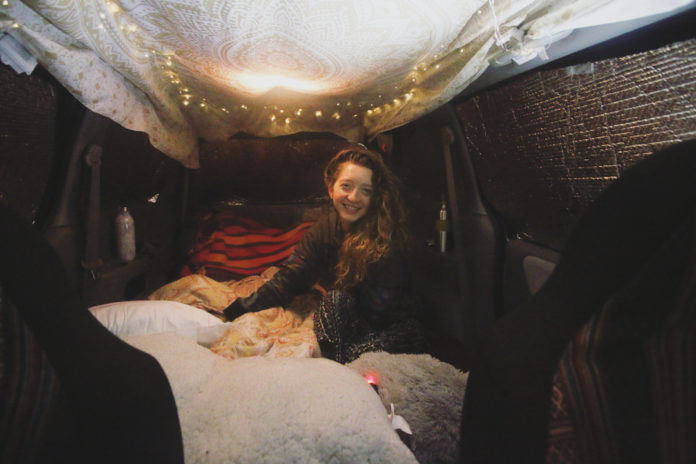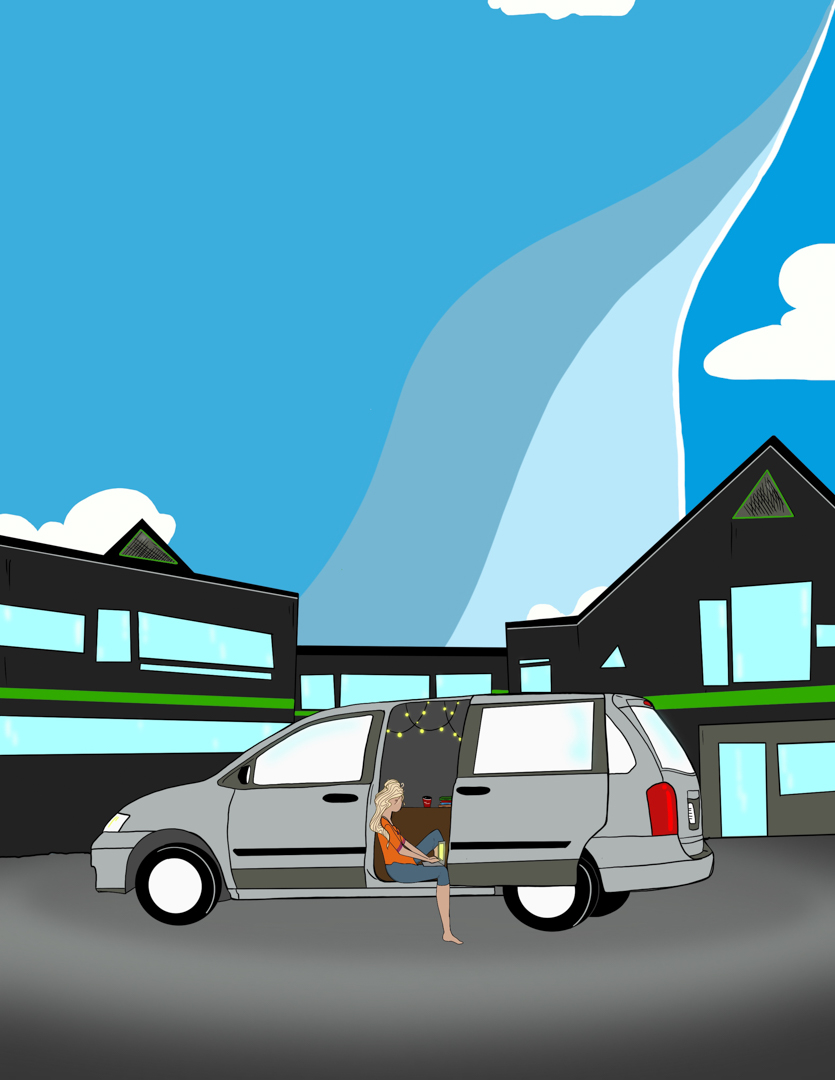 When you think of “vanlife,” what are you picturing? A cute retro VW with a spectacular ocean view? A Sprinter complete with a built-in shower and mini-kitchen? Or how about a rusting silver minivan, with a zap-strapped front bumper parked in the darkest back corner of UFV’s parking lot?
When you think of “vanlife,” what are you picturing? A cute retro VW with a spectacular ocean view? A Sprinter complete with a built-in shower and mini-kitchen? Or how about a rusting silver minivan, with a zap-strapped front bumper parked in the darkest back corner of UFV’s parking lot?
I lived in my van for a total of four semesters over a period of two years. I was able to save money and build a community within UFV, all while taking a full course-load of five classes a semester. You are probably wondering how this is possible and have many questions about the logistics of this living situation, such as: did I feel safe sleeping in random spots? How did I make food? Where did I poop? I hope to answer all your questions and more.
In 2018, after travelling around South America and living out of my backpack for five years, I started the journey toward earning a piece of paper that says I am smart (ie. an Arts degree that will hopefully get me a job). Back then, minimum wage dictated I sell the hours of my day for $13 a piece. I could not afford to pay rent on a less-than-living wage, so I lived with my mom all of 2018 while I devised a plan that would allow me to save money while going to school. I was adamant to not rent a run-down basement suite that essentially would have me putting my earnings toward someone else’s mortgage payments. Intoxicated by an Instagram feed full of “vanlifers” living exciting lives, I began to crave that same adventure. I wanted my entire life to be a road trip. I would live in a van.
I wanted to start small, with something affordable, reliable, inconspicuous — something that didn’t scream “someone’s living in me!” I decided to go with a minivan. I searched high and low on Facebook Marketplace and Craigslist for the perfect van that I would call home. I test-drove a handful of vans, got heartbroken as the perfect ones slipped out of my fingers by a faster offer, and finally settled for my silver Mazda MPV. The owner was a bit sketchy, the check-engine light was on, and the tires were totally worn down, but I haggled him down to $1,100 and drove away with it.
Within the first three months of buying the van my radiator busted ($500 repair), my water pump broke (another $500 repair), and the tires had to be replaced ($360). With a handful of other alignments, tune-ups, small replacements, and new fluids, she was a solid little van — road-worthy and fit to be lived in. I maintained her as best I could: learned how to change a blown fuse, jumped her battery with the help of passing cars, rotated her tires, and changed her oil on a regular schedule. She was my home, and I tried to look after her.
Next came furnishing my new dwelling. First, I took out all the seats in the back so I could build off an empty canvas. The first purchase I made was a foldable, memory foam mattress to sleep on and some plywood and 2x4s from Home Depot to make a flimsy bed frame. I also bought some wooden crates from Home Depot that would fit under the bed frame and act as my closet. I borrowed my mom’s old cooler to store my food in and bought a little camp stove off Facebook Marketplace. I bought strings of fairy lights and a mandala tapestry to staple to the ceiling to make it feel more home-y. I cut window coverings out of reflective material that I would velcro on the inside of each window at night to keep people from peeking in.
My furnishings were rearranged as I slowly settled into a routine and figured out what worked best. After designing and building a few different bed frames, I decided to nix the structure all together and just make the entire floor of the van my bed. While having a bedframe meant more storage space, my back ached from curling up my 5’10” body on a thin piece of plywood that was just under five feet long. So, I limited myself to just a duffle bag full of clothes and sprawled out over the entire floor of my van. This also allowed me to sit up in bed and even gave me enough room to have a guest over, if they were up to an adventurous sleepover.
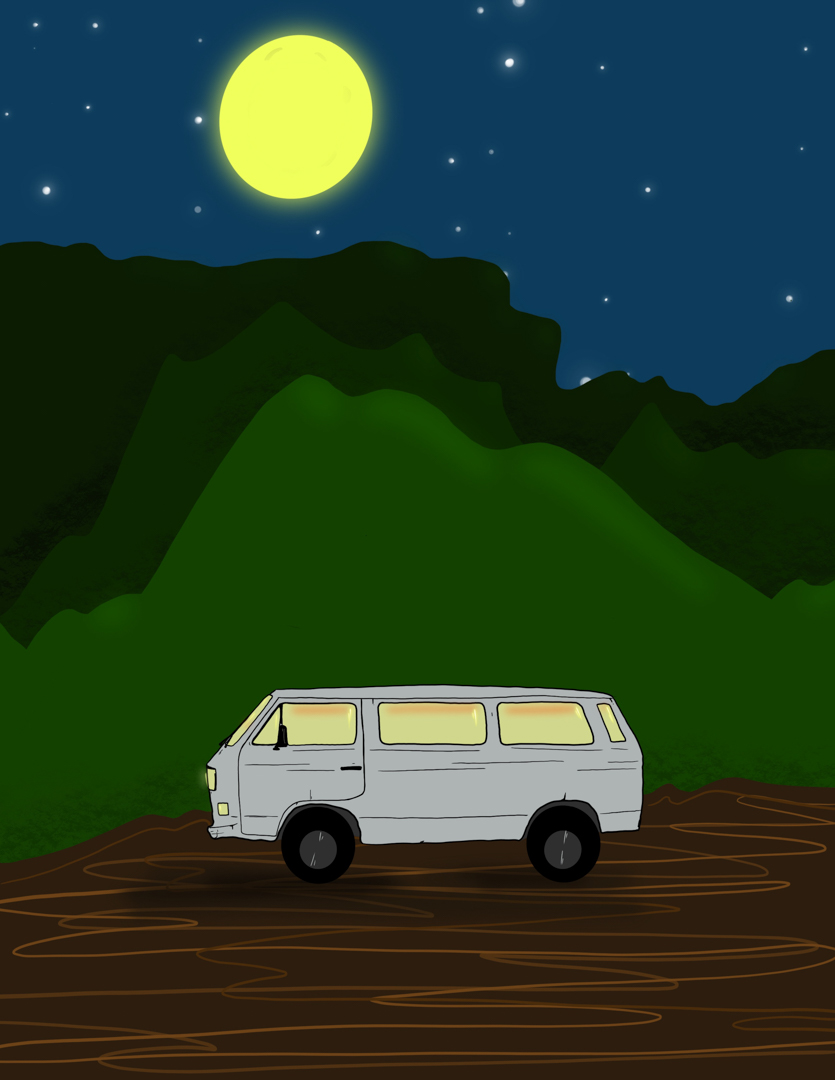 Vanlife is as simple as sticking a mattress in your car and sleeping on it. To this day, the most expensive piece of equipment I’ve bought for my van is my Jackery portable power station for $260. Almost everything, including the van itself, I bought used from thrift stores or Facebook Marketplace. The first mattress I bought for the van was ruined by an unruly Yeti mug full of coffee and an unfortunate spill of tomato soup. Not wanting my van to smell like sour soup, I threw out the mattress and lined the floor of my van with the cushions from my mom’s patio furniture and piles of pillows. With a bit of creativity, frugal solutions to all of life’s little problems are possible.
Vanlife is as simple as sticking a mattress in your car and sleeping on it. To this day, the most expensive piece of equipment I’ve bought for my van is my Jackery portable power station for $260. Almost everything, including the van itself, I bought used from thrift stores or Facebook Marketplace. The first mattress I bought for the van was ruined by an unruly Yeti mug full of coffee and an unfortunate spill of tomato soup. Not wanting my van to smell like sour soup, I threw out the mattress and lined the floor of my van with the cushions from my mom’s patio furniture and piles of pillows. With a bit of creativity, frugal solutions to all of life’s little problems are possible.
I still spent most weekends at my mom’s house, doing laundry and prepping food for the week that would be easy to keep in my cooler. Soups in Adams peanut butter jars were my go-to meal prep. I would make big pots of soup, stew, or chili and fill dozens of jars that would keep fresh in my mom’s deepfreeze before being placed in my cooler full of ice. I filled my milk crate pantry with cereal, sandwich bread, peanut butter, bananas, almond milk, granola bars, and ramen — all food that required little preparation and no refrigeration. For the weeks when I couldn’t make it home, I cooked simple meals on my camp stove, in the PRLC lounge kitchen, or at friend’s houses.
When I say I “lived in my van” what I really mean is that I slept in my van and stored all my stuff in there. All my living was done on UFV’s Abbotsford campus. I showered in Building E’s locker room showers; I toasted my bread, microwaved my food, and percolated my coffee in the PRLC lounge kitchen; I rented a locker from SUS to store my books and course materials in so they wouldn’t become crinkled; I brushed my teeth and washed my face in the washroom on the second floor of Building S that no one ever goes in; I found quiet study spots in every nook and cranny.
I went to every student event that promised free food and the chance to make friends. Anyone remember “Waffle Wednesdays” in the Global Lounge? I got a job working at the front desk in Building E where I swept the gym floors and occasionally snuck in a load of my laundry in between washing varsity jerseys. I become a staff writer for The Cascade and spent most of my time outside of class in the office of S2111, doing my homework in the boardroom and taking naps in a quiet room all while making a few of the best friends I’ve ever had.
I lived in my non-insulated structure over the course of two snowy winters. I stayed indoors until the buildings were locked up for the night. I warmed up my van by driving her around for about 15 minutes, blasting the heat and getting it almost intolerably hot. Then I pulled into my parking spot, turned off the engine, velcroed my blinds on the windows, and burrowed under the covers. This strategy made the van warm enough to fall asleep comfortably in, but it slowly cooled over the course of the night. There was one morning I woke up shivering and so uncomfortably cold that I could not get back to sleep. The inside of my windows were slathered with condensation and the outsides were coated in frost. It was 5 o’clock in the morning. I drove to Starbucks, ordered a black drip coffee, and sat inside while I warmed up and waited for the thrift stores to open. I bought seven blankets and the warmest pajamas I could find from the Salvation Army thrift store. I slept in a nest made of second-hand fabric for four nights before I could make it back to my mom’s place to do loads of laundry.
I relied on many of the friends I had made while going to every social event I could find on campus. I showered in their houses, used their freezers to store my jars of soup in, and slept on their couches during particularly cold nights. Vanlife taught me to accept the gracious hospitality of so many and to find the resources available to students that often go untapped. I was no longer a commuter student. Instead I found community within the school that everyone said offered none.
Every season had its own ups and downs. Winters meant frigid nights, but at least my food kept for longer because the ice in my cooler never melted (except my bananas, which turned black from the cold). The hot summers had me using every fridge available to me on campus — mini fridges galore — because my cooler ice turned to slush within a day, and I couldn’t afford to keep buying fresh bags.
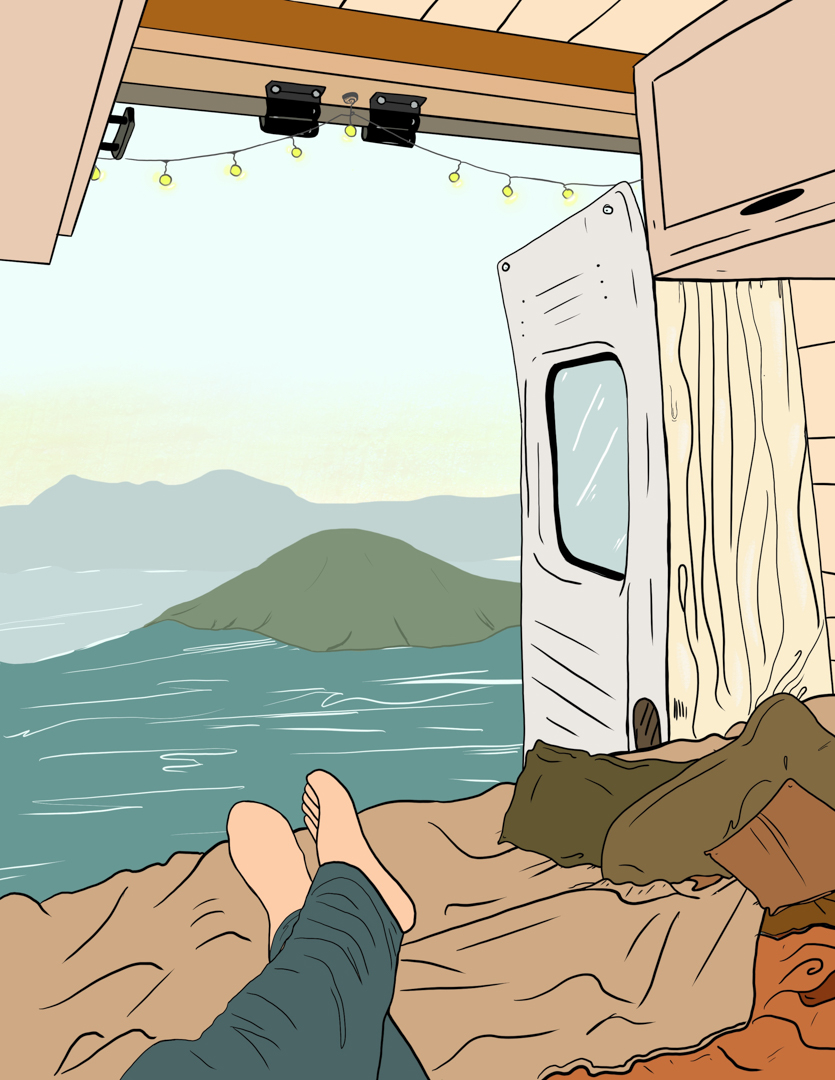
I parked my van and slept in the darkest corner of the parking lot near the dorms where other student’s cars were regularly parked. The security guards must have known, but if they did, they never bothered me. I didn’t make what I was doing a secret, but I didn’t want to draw attention to my situation either just in case I was evicted from my favourite sleeping spot. My rent was essentially $75 a semester — the price of a discounted parking pass at UFV.
I have woken up to the red and blue flashing of police lights a handful of times. Often the firm knocks on my windows would wake me up, except for that one time they shook me awake by rocking my van back and forth. I would dart into the front seat and tell the police officer that I had just gotten tired driving home from my night shift and decided to nap in my car instead of risking falling asleep at the wheel. As a young, pretty white girl, I came off as non-threatening and some officers even acted paternal toward me, saying things like “I would never let my daughter sleep at the side of the road in this neighbourhood like you’re doing.” I am certainly not your daughter, but thanks for your concern. I never felt unsafe sleeping in my van. I never had a reason to.
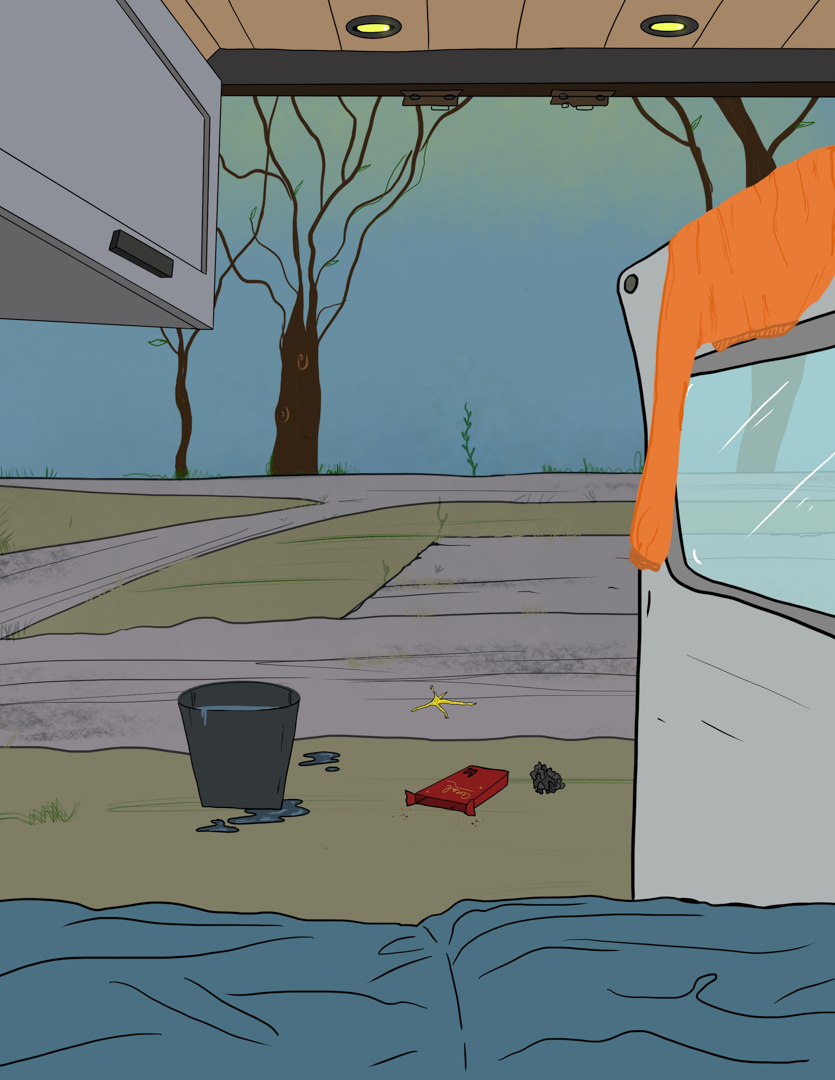
Through living in my van, I experienced more human kindness and pleasant interactions than I ever have living in a “normal” house. One summer I had gotten a little too comfortable in the parking lot near one particularly popular walking trail in Mission, and a lady tapped on my window and gave me $100 cash because she saw I had been living in my vehicle and wanted to offer her assistance. After insisting that I had a full-time job and I was living in my van completely by choice, she still forced her money upon me. That $100 filled my gas tank and bought me some groceries.
When the COVID-19 pandemic shut everything down in March 2020, all the resources I had used to live were no longer available. Every washroom I once used became closed to the public, all the available mini-fridges and microwaves were taped off, friends closed their doors to guests, and the Abbotsford Rec Centre no longer allowed people to use their showers. Over the summer of 2020, if I was not working, I would be outside. I slept in the parking lots of whatever parks I wanted to hang out in the next day, or near the trailhead of whichever mountain I wanted to explore. I bathed in lakes, oceans, and forest streams. I road tripped to hidden gems on my days off, and I slept in underground parking garages after my graveyard shifts to avoid being cooked alive in a scorching hot van. I heated my food up on my camp stove in the parking lot of UFV’s Mission campus. I peed in more bushes and dug holes for more poop than I care to tell you about.
As 2020 came to a close and another winter was slowly creeping up, restrictions on the resources I needed to live comfortably in my van still were not available to me. In November of 2020, I moved into a room in a nice lady’s house and became roommates with six cats. While I was able to save a lot of money living in my van, build a strong community, and grow more resilient than ever, my values had changed. After nearly two years of vanlife, I wanted to hang my clothes up in a closet, be able to use the washroom in the middle of the night, and have a hot shower at the end of the day instead of settling for baby wipes. I wanted a warm home to relax in and a space to be able to offer hospitality to others. I wanted a kitchen to be able to cook meals every night instead of heating a pot of soup over my dinky camp stove. If I have to pay half of my income every month for these little luxuries, so be it.
Vanlife was a fun, challenging adventure at first, but slowly became tiresome and extremely inconvenient. I still use my minivan as my main commuter vehicle and as a camper van on weekend trips. I would definitely consider vanlife again in a bigger vehicle with a few more amenities, but my days of living in a minivan are over.
Still have questions or want to know more? Email me at andrea@ufvcascade.ca to connect. If you want to learn more about vanlife, check out the many Facebook groups on the subject. One group I found particularly helpful was Solo Female Vanlife, as well as r/vanlife on Reddit. Read Mitch Huttema’s article from 2016, “Advice from a van dwelling student.” If you want to save money and learn how to become more resourceful, try living in your van. It’s possible.
Images: Niusha Naderi/The Cascade
Andrea Sadowski is working towards her BA in Global Development Studies, with a minor in anthropology and Mennonite studies. When she's not sitting in front of her computer, Andrea enjoys climbing mountains, sleeping outside, cooking delicious plant-based food, talking to animals, and dismantling the patriarchy.

